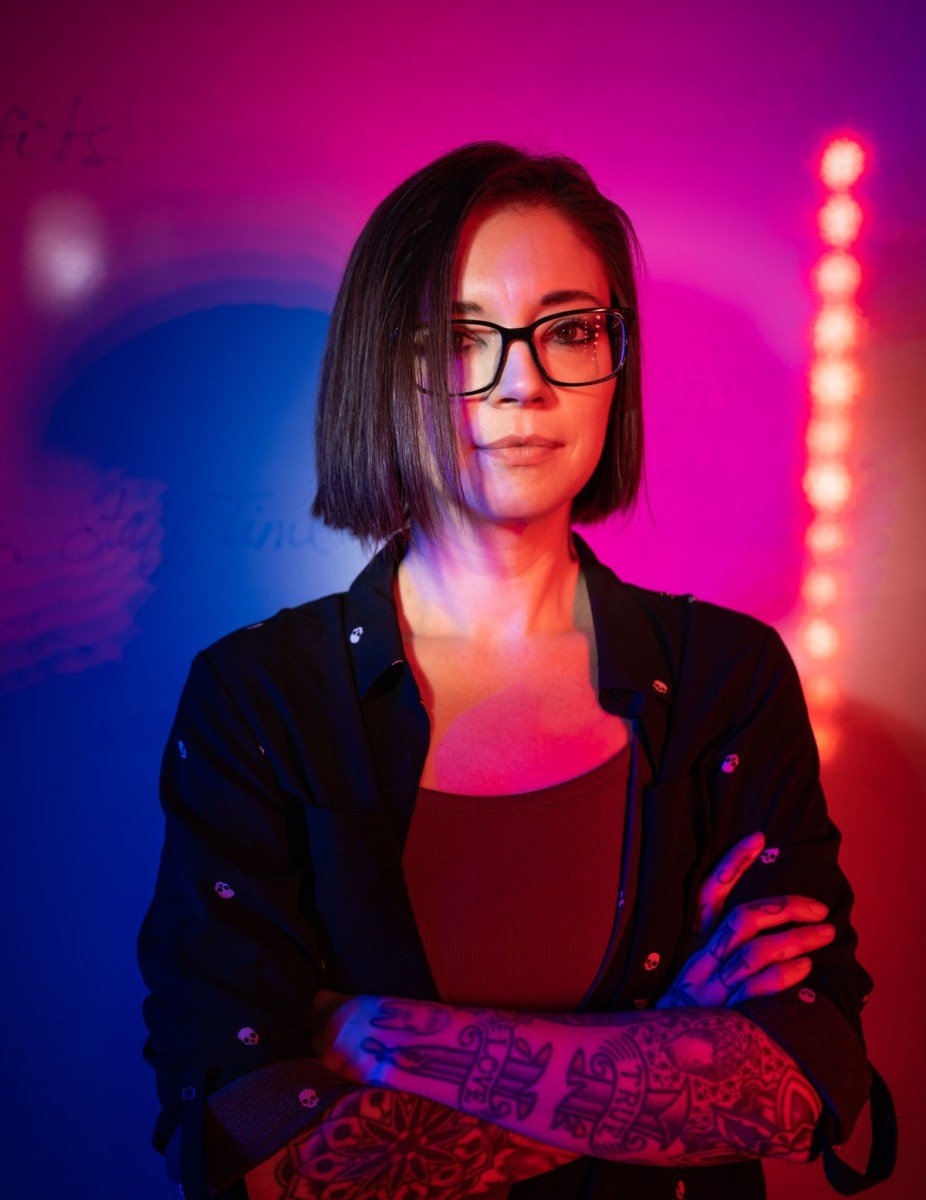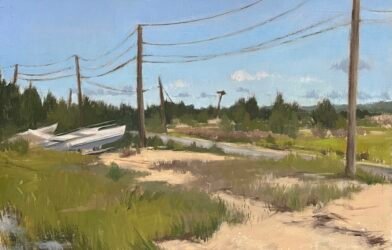Brittany Noriega now derives all her income from the arts. (photo by Jim Barcus)
Poet Natasha Ria El-Scari explores the strategies, challenges and rewards from the perspective of her own experience and that of three full-time artists
I spent my early years with only one full-time artist, my paternal grandmother. I met her when she was 55, and at that time people could actually retire and live on their retirement. Yet my grandmother busied herself with what she called her hustle, which is now what we know to be the business part of being a full-time artist.
She made custom drapery and art for wealthy families, and she had her own store inside the Conference Cove on 31st and Troost, where she made custom African American dolls that rivaled Cabbage Patch Kids. All the while she would tell her grandchildren they should always have a legal hustle. Without my grandmother’s example, I don’t think I would have known how to jump directly into my full-time artistry. Fourteen years ago when I had the courage and opportunity to jump, I did, working full-time as a performer, poet, editor, life coach, knitter, spiritual card reader and owner of the Natasha Ria Art Gallery. Additionally, I created and led Black Space Black Art, was a workshop facilitator and authored six books and produced four CDs.
In 2023 I returned to traditional employment full time, and that was because I wanted more stable health care, a matching retirement and steady income. The truth is I became quite savvy at understanding that having large amounts of money didn’t mean I needed to spend it, and I learned how to navigate the free and low-cost health system to get decent care. I was a single mother with two children and able to maintain life. There were moments I needed grace and assistance, but by and large my family was able to do all the other things other families did on a sole artist salary.
In 2023, I married an artist and full-time musician, Kevin Church Johnson. While we were still dating, I took over the management of his career and was able to significantly elevate his income. Like many full-time musicians, he was trapped in what is seen as the normal way many African American musicians are expected to live, while others benefited directly from their talent. Through Kevin’s career, I met many other full-time musicians, and like any other art form, the life of a full-time artist takes a variety of paths. Each day, artists of all types have to deal with the negativity of people with traditional employment who tell them to “get a real job” or that their art is “a hobby.”
The truth is many full-time artists exist quietly for fear of unwanted attention; or, as unofficial gatekeepers, the few that have been able to create a sustainable life feel the deep need to protect their resources. In art, unlike the practice of medicine or teaching, the educational attainment of an artist does not guarantee their success.
When I started teaching at the Kansas City Art Institute four years ago, I learned early the class distinction between commercial artists and fine artists. Students referred to themselves as the “struggle” artists and the “sellout” artists. Too often, we have placed debilitating monikers on what it means to be a full-time musician, and we falsely assume that all artists want the same thing and the same lives. I decided to sit down with a few full-time artists who were willing to share about their careers; one is a visual artist and the other two are musicians. I asked them all the same questions, including what their definition of a full-time artist consisted of, the length of time they have been a full-time artist, the challenges they face and the support needed for artists.
Brittany Noriega
Over the years I have learned that being a full-time artist sometimes means that you work another “job” to support your artistic career. I am very privileged, and for me, all sources of my income happen to be in the arts. I work for the InterUrban ArtsHouse as the ArtsConnect program manager, I run an art zine called Core, and I have my personal arts practice. My personal practice is based in drawing, but being an artist also involves applying to shows, writing, formatting, photography, administrative tasks, recordkeeping, etc. It’s never just making the art. The jobs are essentially never-ending, and many of them involve unpaid work.
I have been a full-time artist for over a decade. It has looked different over the years, but I have been stubbornly determined to be an artist in some way for most of my adult life. Before I moved to Kansas City in 2015, I tattooed and owned my own shop for seven years. After moving here, I began to focus on the contemporary fine art world, selling my work, doing group shows and pop-ups. I was a server and bartender while doing the art pop-ups, and things have gradually grown from there. I began helping with ArtWorks classes through InterUrban ArtHouse in 2021, got an artist residency there in 2022, fell in love with the people and staff, and began working as a staff member in January 2023. Being a full-time artist is rarely a one-track road.
People often appreciate the art but not the work that it takes to do it. This is true in all art forms. It also involves a lot of unpaid labor, a lack of continued opportunities, people trying to pay with “exposure,” etc. There is a gap between wanting to see the art, or hear the music, or watch the play/movie . . . and understanding the work that goes into making these things happen. Lastly, artists need money, time, and understanding to support their art.
To learn more about Brittany and to support her art visit www.bmnoriega.art, www.corezinekc.com, and www.interurbanarthouse.org.

Kevin Church Johnson
I am a singer, songwriter, producer and multi-instrumentalist. My main instruments are drum and voice. I sing/play for weddings, engagements, funerals, concerts, sacred services, corporate bands and production, and I have my own band as well. Any given day can consist of so many different things and genres. I must have fresh material, fresh performances, great tools, and I must know the trends. I have to have the latest gear, all while staying my true self as an artist. I don’t like teaching at all, but I have had some single technique drum lessons and a few long-term voice students.
I have been a full-time artist since my early 20s. I have had a few short-lived supplemental income jobs, but they never lasted long, because the work of a musician is around the clock and employers rightfully can’t always handle that. I started playing in church at the age of 5. I toured with R & B legend Ginuwine for almost seven years. I have been to Africa and the Caribbean to perform.
Closing off unhealthy thinking, listening to God, trusting and having faith in myself, listening and trusting my own path is a constant for me. Social media is a challenge too, but my manager (wife) keeps me on top of that. I have a hard time sharing about my gigs because I am focused on working them, but that is how you get more work, so I am working on it each day. It never helps to be shy, but I push through.
You have to have a lot of faith and self-esteem to be a full-time musician. You have to have networking skills, the proper clothing and money to buy the gear and clothing you need to be in formal spaces and for videos and more.
I have seen a lot of great opportunities due to my manager (wife). I don’t always like the feedback she gives, but as a full-time artist, having someone to do the administrative work makes a huge difference. She doesn’t drop the ball, and that is just something I don’t do well. Her management gives me a chance to focus on the creative aspect, and it is worth finding someone you trust. I highly recommend it.
For more about Kevin Church Johnson:
www.kevinchurchjohnson.com
IG: kevinchurchjohnson
FB: Kevin Church Johnson

Peter Schlamb
I saw Peter perform around town for years, but it wasn’t until I spent time with him weekly that I got to know him during a residency at a local jazz club. Peter is a kind natured man by demeanor and appearance. He typically has a kind look and pleasant word to offer anyone. Musicians’ lives are clearly different from those of visual artists, but there are similarities to the lifestyle.
Currently my “jobs” as a full-time artist include performing, recording and teaching music. When I’m in Kansas City, I have regular public restaurant/club performance dates on vibraphone/piano/keyboards and I perform at private engagements. I am hired to play on various recording projects. I am an adjunct faculty member of the UMKC Conservatory teaching in the jazz department. Additionally, I am hired to perform outside of Kansas City for individual engagements as well as touring with various groups and projects.
I would say I’ve been a full-time artist (which to me means that performing music has been my primary focus/occupation/source of income) for about 20 years. I started regularly performing jazz gigs around my junior year of high school, and I’ve been fortunate to grow and sustain a career in music. I have a bachelor’s degree from the New School University in Jazz Performance (2010). I started piano lessons at age 5 and percussion/vibraphone lessons at age 10. I started studying and playing jazz at age 10.
There are several challenges to being a full-time artist, which include:
- Balancing open creative time with highly structured work time
- Balancing revenue earning with artistic output and making choices that support artistic growth and financial growth or solvency
- Organizing a schedule that has a lot of moving parts and a variety of short- and long-term deadlines
- Growing and maintaining professional and personal relationships and being comfortable navigating a wide variety of social and professional situations
Artists need financial and emotional support. Without proper financial support (whether that comes from gig work, grants, or other financial sources), full-time artistry is not possible for most people. Without proper emotional support from family, friends, loved ones and self, artists struggle to maintain a life where they can be vulnerable and have a significant creative output.
For more about Peter Schlamb:
IG: electrictinks
YouTube: Peter Schlamb – Topic
Being a full-time artist isn’t a one-path journey. Each story, including my own, has a series of twists and turns but one thing is certain: A full-time artist must be brave.









